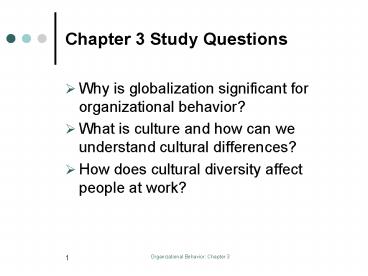Chapter 3 Study Questions PowerPoint PPT Presentation
1 / 17
Title: Chapter 3 Study Questions
1
Chapter 3 Study Questions
- Why is globalization significant for
organizational behavior? - What is culture and how can we understand
cultural differences? - How does cultural diversity affect people at work?
2
Study Question 1 Why is globalization
significant for organizational behavior?
- What is Globalization?
3
Study Question 1 Why is globalization
significant for organizational behavior?
- What are the Forces of globalization?
4
Study Question 1 Why is globalization
significant for organizational behavior?
- Globalization is contributing to the emergence
of regional economic alliances. - Examples
- European Union (EU).
- North American Free Trade Agreement (NAFTA).
- Asia-Pacific Economic Co-operation Forum (APEC).
5
Study Question 1 Why is globalization
significant for organizational behavior?
- What is Outsourcing?
- Definition
- What is Off shoring?
- Definition
- What is Job migration?
- Definition
6
Study Question 2 What is culture and how can we
understand cultural differences?
- What is culture?
- Definition
- Values and national culture.
- The most widely used research for understanding
differences among national cultures was done by a
Dutch organizational anthropologist named Geert
Hofstede.
7
Study Question 2 What is culture and how can we
understand cultural differences?
- He surveyed 160,000 managers and employees of IBM
in 60 countries about their work-related values. - He found that managers and employees vary on five
dimensions of national culture. - Hofstedes five dimensions of national culture
- Power distance.
- Uncertainty avoidance.
- Individualism-collectivism.
- Masculinity-femininity.
- Long-term/short-term orientation.
8
Study Question 2 What is culture and how can we
understand cultural differences?
- Power distance.
- The willingness of a culture to accept status and
power differences among members. - Use of titles and formality, by passing authority
is seldom seen. - Managers and employees see each other as
different. - Example of a high power distance culture
Indonesia. - Example of a low power distance culture Sweden.
9
Study Question 2 What is culture and how can we
understand cultural differences?
- Uncertainty avoidance.
- Is the extend to which a culture feels threatened
or discomfort with uncertainty, ambiguous
situations and risk and tries to avoid them. - Preference for structured versus unstructured
organizational situations. - Example of a high uncertainty avoidance culture
France. - Example of a low uncertainty avoidance culture
Norway, Australia
10
Study Question 2 What is culture and how can we
understand cultural differences?
- Individualism-collectivism.
- Is the degree to which people in a country prefer
to act as individuals rather than as members of
groups. - Example of an individualistic culture United
States, Great Britain, Canada - In a collectivist culture
- The emphasis is on the group and harmony of the
group. - Group decision making is the norm.
- Example of a collectivist culture is Japan,
Mexico
11
Study Question 2 What is culture and how can we
understand cultural differences?
- Masculinity-femininity.
- The tendency of a culture to value stereotypical
masculine or feminine traits. - Emphasizes competition/assertiveness versus
interpersonal sensitivity/relationships. - Example of a masculine culture Japan.
- Example of a feminine culture Thailand.
12
Study Question 2 What is culture and how can we
understand cultural differences?
- Long-term/short-term orientation.
- The tendency of a culture to emphasize
future-oriented values versus present-oriented
values. - Adoption of long-term or short-term performance
horizons. - Example of a long-term orientation culture
South Korea, Japan, China - Example of a short-term orientation culture
United States.
13
Study Question 3 How does cultural diversity
affect people at work?
- Multinational corporation (MNC).
- Definition
14
Study Question 3 How does cultural diversity
affect people at work?
- Multicultural workforces and expatriates.
- Expatriates-Who are they?
15
Study Question 3 How does cultural diversity
affect people at work?
16
Study Question 3 How does cultural diversity
affect people at work?
- Ethical behavior across cultures.
- Ethical challenges result from
- Cultural diversity.
- Variations in governments and legal systems.
- Prominent current issues.
- Corruption and bribery.
- Poor working conditions.
- Child and prison labor.
- Business support of repressive governments.
- Sweatshops.
17
Study Question 3 How does cultural diversity
affect people at work?
- Are management theories universal?
- Answer is?

